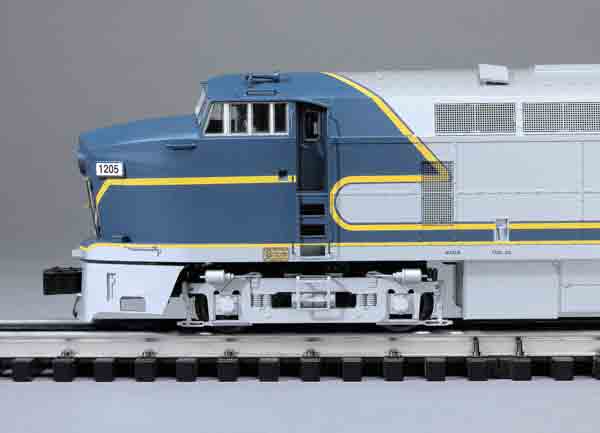Now Lionel has released an A-A set of this distinctive locomotive, featuring a good level of detail and O-36 operation.
In the world of real railroading, the Sharks were a capable enough product, but the model largely came too late (1950) to win a major share of the locomotive market. Baldwin did crank out 109 A units and 51 B units for the Baltimore & Ohio (31 total), New York Central (26 total), and the Pennsylvania RR (103 total). Often their final years were spent lugging heavy freight or coal trains or doing transfer work. Dirty but essential tasks.
The last NYC units were sold to the Monongahela Ry., and two of them ended up on the Delaware & Hudson. The last report of those two forlorn units is that after changing hands again, they are in secure storage somewhere “unknown.”
Opening the box
When I took this Lionel model out of the box, two details struck me – and no, it wasn’t the nose, it was the recessed cab doors and the detail of the side screens. These were wow-factors for me even before putting the train down on rails. It has been a while since secondary visual detail has so captivated me.
The nose looks great. To me it scores on the melding of the gentle curves and the angular seams, pointing downward in a V-shape toward the pilot. The die-cast metal pilot doesn’t have much detail on it (there is an add-on brake line), but neither did the real thing.
The slim deck around the nose has grab irons situated above the footholds, and grab irons bracket the nose hatch.
The door has an add-on handle that is painted D&H Orange for high visibility. A headlight is at the top of the snout, and illuminated number boards are on the sides of the curved nose.
Grab irons can be found over both the windshields and the side windows. The side windows are nicely done in a simulated four-pane style. There are very tiny holders for flags above the second pane.
The roof is functional, yet detailed. There are simulated lift rings (they are, in fact, solid) on the hatch placed over the locomotive’s prime mover. This lift-off section is held on by magnets. Control access is beneath this section.
I previously mentioned the recessed side cab doors. The door appears to be recessed far enough into the carbody that an O scale figure could stand on the ledge and still be under cover.
There are also three very deep steps below the cab doors. All four of the main doors (two cab, one hostler door, and the rear door) are sprung.
The end of the unit has grab irons for easy crew access and a backup light.
The body has nice rivet and seam detail, and you’ll find seven double-pane screens – one on the side and six on the gently inward arcing upper section.
The die-cast metal trucks look great with the cast-in rivets and other detailing being clean and crisp.
Paint application was fine. There were a few spots in tough-to-paint angular areas where the yellow striping didn’t quite cover the blue. High points were the three D&H shields and the Baldwin-Lima-Hamilton builder’s plate on each side.
On the test track
The sound system was good, but I expected a bit more of what I call the “This baby’s gonna blow” noise, since, after all, it’s a Baldwin. Those interesting sounds were mainly heard upon startup and at very low running speeds. Once it was underway, you basically hear a hypnotic thrum or throb of engine operation.
The bell was nice, and the horn was a distinctive sounding bleat.
User and volume controls are located beneath a removable exhaust lid at the rear of the unit.
Smoke fluid is added by removing a square vent plug on the fireman’s side of the unit. The exhaust flows out through a round screen about an inch away, and the smoke flow was steady.
The nose couplers are coil couplers, and the rear coupler is a dummy coupler.
Each truck has two power pickup rollers spaced about 3 inches apart.
Our command-mode low-speed average was 2 scale miles per hour, while the conventional-mode low-speed average was 8.9 scale miles per hour. The high-speed average was 99.1 scale miles per hour. A single motorized unit’s drawbar pull was 2 pounds.
The RF-16 is one of my favorite locomotives, and Lionel’s version is fun to look at and fun to run. It evokes the bygone days of the first generation of railroad dieselization, while delivering first-rate performance for your railroad.
Features: O-36 operation, two can-style motors (powered A or B units), Legacy command and sound systems, Odyssey speed control, coil coupler on front of the A unit, smoke units















Great models. As a NYC fan and a custom painter, I checked out the paint & found it to be pretty accurate. Running characteristics are good and the sound volume can be adjusted. Legacy gives the operator many options with speed, sound, and operation of turnouts and other accessories. There is more, but thisis not meant to be a complete review. Suffice it to say that I am pleased with my Shark ABA combination.
Horse
Beautifully painted engines in terrifically prototypical style. The first thing I'd do is get those units much more closely coupled. They really deserve Kadee-style coupler replacements to help smooth out the lines of the consist. Thanks for the view of them in action.
Excellent Styling. I would like to see the pennsylvania colors and the B unit as well.
I like the D&H scheme I have D&H RS11 in that color scheme and it is a sharp locomotive. This color scheme makes this locomotive very appealing.
Great write up on the real and model versions! Would love to know where the real ones are hidden!